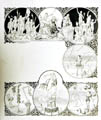Act: Equilibristic
| Alternative Names:
|
| Description: |
|
Rope dancing, wire walking, rope walking, tightrope walking or its Latinate name “funambulism” is one of the oldest of circus entertainments. It can be traced back thousands of years to ancient Rome. Tightrope walking is usually performed on a 5/8-inch wire or rope, suspended thirty or more feet above the ground. Some acts are performed closer to the ground, called slack wires (wires that are not taut), tight wires (wires with no give) and bound wires (wires that have a spring at one end that will allow some give, but returning the wire taut). In the 19th century a number of walkers emerged. However, Jean Francois Gravelet (1824-1897)—known as Blondin—garnered great attention. Blondin was born in St. Omer, France and attended Ecole de Gymnase in Lyon for his training as an acrobat. Blondin is generally considered as the first great wirewalker. His notoriety was gained by his antics on the tightrope and his showmanship. In 1859, Blondin stretched a rope 1100 feet long and 160 feet above Niagara Falls. He crossed from the American side to the Canadian side and returned. Blondin repeated this feat numerous times, each time adding more showmanship to the walk. One trip he carried a man on his back, another trip he was blindfolded, another made one trip walking on stilts. In the twentieth century, Bird Millman gained recognition as a tightrope walker. Like Blondin she executed daring spectacles, but brought them into the Jazz age. Instead of stilts and blindfold, she sand and dance across a thirty-six foot wire, twice as long as the normal low tight wire giving her more flex in the wire. Bird was the first American to work on the wire without the aid of a balancing object. Con Colleano, one of the finest low wirewalkers, was the first to accomplish the very difficult forward somersault on the wire. The tick is difficult because the performer’s feet must lead the arc over his head and find the wire before he can see where to place them. His first attempt at the trick resulted in four misses before accomplishing it on the fifth try. Joining the Ringling Bros. show in 1925, his act became legendary. Colleano danced on the wire while the band played Ravel’s “Bolereo,” he would throw a backward somersault and remove his trousers in the air as he turned. Con Collano was the first “man” not to use a balance umbrella. While many wirewalkers have enjoyed success, the Wallendas are perhaps the most recognizable name in American Circus history. With their daring feats, there fame on the wire continued to grow. They reached the zenith of their popularity when they stunned audiences with a seven-person-three high pyramid in 1947. The Wallendas were headliners with Ringling Bros. and Barnum & Bailey Circus during the 1930s and 40s. With the glory of any spectacle comes great danger. A number of performers have fallen to their death and many have been crippled. High wire walkers prefer not to work with safety nets, not only because they feel it would be dangerous to fall onto a net among balance bars and props, but also because they believe a net makes falling more psychologically attractive. The walkers work to maintain their center of gravity always over the wire. If they feel like they are about to “go down,” they never permit themselves to fall to the side; the will fall straight down where they can grab the wire and remount it. |
| Related People |

|

|


